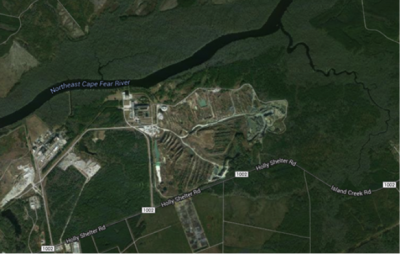
Third in a series.
CASTLE HAYNE — A battle has been brewing for more than seven years over Titan America’s plans for a limestone mine and cement-manufacturing plant on the banks of the Northeast Cape Fear River. Much of the opposition has been based on the plant’s possible threats to regional air quality, but many are also worried about its possible effects on the area’s drinking-water supply.
Supporter Spotlight
Titan’s subsidiary, Carolinas Cement Co. announced in 2008 its plans to build a modern cement-production plant at the former Ideal Cement Co. site on the south bank of the river in northern New Hanover County. Ideal Cement Co. closed in 1982. Titan, which has a corporate parent based in Greece, wants to build a new plant, expand the existing mining operations and produce up to 2.4 million tons of cement each year. The company had initially planned to have the new plant up and running by 2011.
“The project is still going but it’s taking a lot longer than we thought it would. We’re still progressing with the project,” said Bob Odom, Carolinas Cement’s general manager. “We’ve still got a long way to go. It will be 2020 at the earliest before this plant gets going.”
Carolina Cement is moving forward with a smaller-scale part of the project. A bulk cement-bagging operation at the site is now fully permitted and construction has begun on the building. The bagging operation was allowed to proceed with no need for a county special-use permit, a zoning process that opponents are hoping to use to block the company’s broader plan.
“The bagging operation would be part of the new plant but right now it’s a separate operation,” Odom said.
‘Good Neighbors’
Some in the community support the Carolina Cement’s expansion plans, citing the potential for job creation and other economic benefits. A group called the Coalition for Economic Advancement was formed to support the project. Supporters also say Titan has a long history as a responsible environmental steward.
Supporter Spotlight

“Sustainable Development is a top Group and Company priority, deriving from our Governing Objective and Values and aiming to combine business goals and long term economic performance with respect for people, society and the environment,” according to Titan America’s website. The company says the plant here will be built with the most advanced pollution controls of any cement plant in the world.
Odom said the company’s operations here will be similar to its plants in other communities where it operates, namely Roanoke, Va., and Medley, Fla., just north of Miami.
“We’re good neighbors there and we’ll be good neighbors here,” Odom said. “We haven’t done the best job getting that information out but once we’re here, everybody’s going to say, ‘What was the big deal?’”
The project is a big deal to many in the Wilmington area. Opponents, many of whom became engaged in more than a half-dozen grassroots organizations that eventually came together to form the Stop Titan Action Network, say the operation will be a major polluter.
The Southern Environmental Law Center says the project’s cement kiln and expanded rock quarry would require the destruction of about 1,000 acres of wetlands and would be a major new source of mercury pollution in the Northeast Cape Fear River, which is already impaired by the neurotoxin. The facility would also emit significant quantities of other pollutants, including carbon monoxide, lead, cancer-causing benzene and hydrochloric acid, as well as carbon dioxide, according to SELC, which represents groups that challenged the state air-quality permit for the plant.
Titan will need more than 16 federal, state and local permits to operate. So far, the only permit issued is the state air-quality permit. The case challenging that permit is pending in the courts.
Meanwhile, opponents have shifted their focus to the potential effects the Carolina Cement’s mining operation could have below ground. The company’s proposed open-pit mine would go down about 80-85 feet, requiring heavy pumping of groundwater. Public-water purveyors are also paying close attention.
“I can say it’s on our radar,” said Mike Richardson, water resource manager with the Cape Fear Public Utility Authority. “Anytime you have a mining operation with a considerable amount of water being pumped out there’s potential for a problem. You never really know until it’s pumped out.”
Titan’s proposed new 1,868-acre mining site is about six miles north of an authority’s water treatment plant and its well field, which started operating in 2009. Richardson said the plant is an important part of the authority’s overall resources in that part of the county.
“That plant is 20 percent of our water production,” Richardson said. The remainder of the authority’s water production comes from the Cape Fear River.
The extent of the mine’s effects on the plant will be difficult to estimate because of the complex nature of the groundwater system, according to a 2013 study prepared by the U.S. Geological Survey in cooperation with the authority.
Odom disagrees. He said the effects should be no different than the operations that have gone on for decades at the existing site.
“Mining has been going on here for almost 50 years with no adverse effect on the aquifer. We’ve had no wells go dry,” Odom said. “We currently mine to about 85 feet so there’s no big change in that respect. We’ve seen nothing negative.”
Rep. Rick Catlin, R-New Hanover, said the operation will likely affect groundwater levels, especially where the mine’s draw-down effects intersect those of the authority’s wells. The authority had already experienced problems, such as disappearing ponds and streams, related to over pumping, Catlin said.
“As a hydrogeologist, I think it will be a problem,” he said. “It will have an impact on the water wells in the northern part of New Hanover County. When two draw-downs meet each other they add together.”
How Much Water?
Estimates of the amounts of groundwater that must be removed to allow dry-pit mining at the site have ranged from 2.5-5 million to 10-16 million gallons a day. Odom said the most likely amount is about four million gallons a day. Opponents dispute the figure, noting the company’s 30-year plan requires far more dewatering.

Mike Giles, coastal advocate with the federation, said the company is on record saying its operation will eventually cover more than 3,000 acres and require pumping as much as 16 million gallons per day.
“Titan is not disclosing any information about their project except information they can cherry pick to minimize their effects upon both surface and groundwater resources,” Giles said.
The company plans to discharge the water into the Northeast Cape Fear River but Odom said other options may be possible. Odom said the company had discussed those options with officials at the Cape Fear Public Utility Authority.
“We have spoken with them in the past about dewatering the mine,” Odom said. “We can offer the water to the county if the county wanted it. The question is: How are we going to get it to their treatment plant? It’s a money question.”
Mine dewatering could also affect groundwater supplies in areas beyond New Hanover County, according to a study commissioned by the N.C. Coastal Federation and conducted in 2014 by GeoResources Inc.
Curtis Consolvo is the hydrogeologist at GeoResources who prepared the report, which he described as a review of existing information. Consolvo said comparing the effects at the Titan site with other large industrial operations that tap aquifers, such as the PCS Phosphate Co. mine in Aurora, in Beaufort County, isn’t always as simple as it sounds.
PCS’ mine dewatering accounts for about half of all water withdrawn from the Castle Hayne aquifer for industrial purposes. The Canadian-owned company draws about 65 million gallons of water a day from the aquifer to allow dry-pit mining, and the company’s current permit allows for daily withdrawals of up to 78 million gallons. The pumping creates a cone-shaped depression in the water table that extends outward about 20 miles from the center of the mine, according to PCS.
There was, according to reports, a sudden drop in water levels in wells tapping the Castle Hayne in 1965 when the Aurora operation began. PCS has for 50 years monitored groundwater levels and quality through a network of about 200 wells around the plant site and throughout Beaufort County. PCS said water levels stabilized shortly after pumping started and have remained consistent since pumping began in 1965, with no significant change in the water quality. Because the cone of depression has not grown in size since PCS operations began, the company’s geologists say the Castle Hayne can support the high pumping rate.
The results of the Titan operation in New Hanover County may be different, Consolvo said.
“These aquifer systems are very uniquely characteristic from place to place, so you cannot look at their rates of withdrawal and look at the impacts and apply them to New Hanover (County). The hydraulic properties are location specific,” Consolvo said.
The deeper, Peedee aquifer is also characteristically different, compared to the Castle Hayne aquifer. Water flow is slower in the Peedee so it takes longer to recharge after withdrawals.
Widespread draw-down effects from the Castle Hayne mining site may be more pronounced in the lower aquifer, according to Consolvo’s study. A “broad, far-reaching cone of depression” can be expected in the Peedee aquifer from the draw-down while effects to the overlying Castle Hayne aquifer will be more localized, perhaps affecting local wells and potentially reducing recharge rates to the Peedee aquifer for the affected area, according to the study.
“I had found that it looked as though the impacts in the Peedee would be more regional. I can’t name a radius and that’s why those issues are going to need to be studied. You’ll have to collect data to try and name numbers,” Consolvo said.
Consolvo’s study notes that cumulative draw-down from the mining operations at the Titan site could also make wells and well fields tapping the Peedee aquifer in the region more vulnerable to saltwater intrusion.
Some problems described in the study have been seen before. “Past dewatering operations at quarries in the vicinity of the proposed CCC (Carolina Cement Co.) site have a history of affecting residential wells in the area.”
Past quarry operations were connected to problems at 10 area wells in the late 1970s. At the time, the quarry depth was far less, 35 feet, with a mine area of 1,212 acres. “The deeper pumping levels and the larger area may cause more extensive well impacts. Pumps may need to be lowered and/or wells replaced,” according to Consolvo’s study.
Richardson said the authority’s biggest worry is the potential problems with the deeper Peedee aquifer, which is a preferable source because of its higher-quality water.
“Our long-term hopes are that we can continue to use the deeper aquifer. We are monitoring the situation,” Richardson said. “Titan has been on our radar screen for a while. We’re not jumping up and down, we’re just monitoring.”
In addition to the authority’s facilities, well sites in nearby Pender County and at least four other existing industrial well sites within a six-mile radius of the Titan site could be affected, according to the GeoResources study.
Existing Problems
Proposed mining operations at the site could also allow contaminants from an adjacent, former processing plant for chromite ore to spread in the groundwater system. The contaminants are now considered effectively controlled but that could change with large-scale withdrawals.
A pump-and-treat remediation of chromium-contaminated groundwater has been going on since 1975. Dewatering at the site may substantially alter contaminated groundwater flow, according to the GeoResources study. Those effects may also be more pronounced in the lower, Peedee aquifer.
“I think it’s fairly well stated that the remediation that’s been ongoing, you’d have to look at how the proposed pumping would alter what’s already being done,” Consolvo said.
During a six-month reporting period in 2010, about 3,200 pounds of chromium were removed from the upper aquifer and 40 pounds from the lower, with similar amounts removed over the previous six months, the report notes.
Other contaminant releases have occurred at the site. An unknown amount of petroleum leaked from underground storage tanks that were removed in 1989, according to the study. Cleanup efforts have included removal and treatment of affected soils but the extent to which dewatering at the mine would affect contaminant plumes at the adjacent site is unknown.
Odom said his company is aware of the nearby contamination and careful to not exacerbate the problem.
“We are aware of the water problems and we are very cognizant of that. We have followed the rules that have been in effect and we will follow all rules that will be in effect,” he said.
Part I: Drinking Water: An Imperiled Resource
Part II: Researchers Focus on Groundwater







